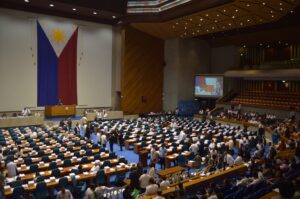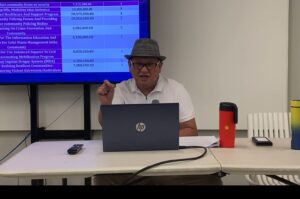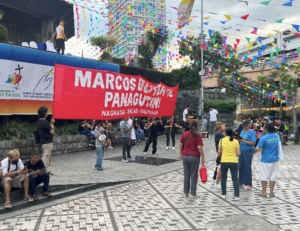“A man is no longer a man confined but a man in debt… . One thing, it’s true, hasn’t changed—capitalism still keeps three quarters of humanity in extreme poverty, too poor to have debts and too numerous to be confined: control will have to deal not only with vanishing frontiers, but with mushrooming shantytowns and ghettoes” (Deleuze, quoted in Han 2012, 43).
I became interested in debt (and people’s relationship with it), when, while growing up, I witnessed how my parents, both public school teachers, managed, but with obvious strain and difficulty, to raise their six children with their meager monthly salary as government employees. My father accepted extra carpentry work on weekends while my mother would rush after school to the house of a wealthy family in the población to give tutorial classes to their children. When my older sister and I were already in university, our parents decided to sell yema which they together cooked and wrapped in water cellophane every night to be sold to students in the high school they taught at the next day; this they did to augment the money they sent us for our allowance every week. Our parents, despite being teachers themselves (my mother an English teacher and my father a Technology and Home Economics teacher), were too exhausted to help us with homework or prepare our meals, so at a young age, all six of us learned how to cook, clean the house, or look after our younger siblings because we felt this was our way to be of help or magpanimbang.
On top of all these extra work they took on, it goes without saying that my parents took out loans, lots of it—they had GSIS loans, loans with Manila Teachers; they borrowed money from the husband of their school principal who offered loans to teachers at exorbitant interest rates, and from our relatives.
My mother retired this year, five years after my father did in 2019. A big percentage of the lumpsum she was paid by GSIS went to paying in full the loans she and my father had taken out in the last 20 years. There was a sense of pride and accomplishment in her voice when she announced this, but I perceived a tone of uncertainty and quiet resignation as she knew that her monthly pension will commence in 2029. Catastrophes can happen within the next five years, and what about their daily expenses? But she’s comforted by the fact that all her debts have been paid up.
So when I read Clara Han’s Life in Debt: Times of Care and Violence in Neoliberal Chile , I was reminded of the life I left behind in South Cotabato and the struggles my parents went through as they waded through debts they incurred in order to send their children to university and to provide for their children left at home who were awaiting their turn to be sent to college.
The 283-page book is an ethnography of the daily life of the impoverished city inhabitants of Santiago, Chile years after the collapse of the right- wing dictatorship of Augusto Pinochet. She began with a historical account of how Chile ended up becoming the first state in South America to experiment with neoliberalism following an exchange with its best and brightest economists who studied at the University of Chicago in the 1950s.
Han describes with lucidity and precision the everyday social and economic battles of select individuals and families in the población of La Pincoya, a toma or illegally appropriated campamento (squatter camps) in the fringes of Santiago during her thirty-six months of fieldwork between 1999 and 2010. The book is organized into six distinct chapters. Han has carefully selected the central characters of her ethnography and richly describes their daily encounters and struggles as they are outlined within dense ties based on kinship and close relationships.
The book attempts to situate in the material lives of the impoverished urban dwellers of Santiago the debts the state owes to them for the inequalities enacted against them that resulted from of its neoliberal policies. Although the change of government in the 1990s led to the reinstatement of democracy and a renewed value given to human rights, the new government and the succeeding administrations failed to attend to the crises experienced by the most vulnerable sections of the population as a result of these policies. It was as if the past is set aside unceremoniously and the victims of human rights abuses and tortures are forgotten in the country’s rush towards its embrace of neoliberalism and democracy.

By examining the everyday struggles in La Pincoya, where people face poverty, debts, and neglect from the government, Han paints a powerful picture of how families face mounting consuymer debts, low wages, and job insecurity. These challenges often lead to issues like domestic violence, drug addiction, mental health problems, and a general gloom that pervades her interlocutors. She also explores how acquiring stuff/consumer goods via credit becomes a way for families to live a “dignified life,” even as their growing debts trap them further in a cycle of government-sanctioned consumerism.
It must be noted, nonetheless, that Han’s ethnography failed to delve into the meaning-making aspect of this debt-fueled consumption across generations within the families she lives with—the children of Sra. Flora who live with her and their father Rodrigo seemed to have not expressed how the debts taken out by their parents impact their own private, domestic lives and what meaning/s they ascribe to their parents’ attempt at a dignified existence. While she argues that the impoverished residents of La Pincoya have become consumers for both the neoliberal market and the state, Han has not presented sufficient data from her ethnography how the acquisition of these consumer goods legitimate the transformation of the people of the toma into citizens of present-day Chile.
It is a national belief that by considering the past as “debt,” and is therefore quantifiable, then poor people and those victims of tortures and state-sponsored violence can be “compensated” through democratization and development. Han, however, demonstrates the limited success of many of these programs underwritten by the state. She observes that these programs target women; the main goal of this, according to her, is for the state to inch closer towards abandoning its responsibilities to its citizens, and leaving it up to the women to fend for the members of their respective families. Many of these programs provide extra assistance to poor families on the condition that social workers conduct monthly visits to check items inside the house that may indicate financial capacity, leading some “clients” to resort to performative poverty in order to stay in the list of poor families that are being given assistance by the state. Despite the enormous outlay of human and economic resources in implementing these anti-poverty programs, they are of little consequence to the lives of the people in La Pincoya because there is an awning divide between what the government contemplates the people need and what its poor citizens actually need. Han adroitly leads the readers to this conclusion and provided sufficient ethnographic data to support the thesis of her book.

Notwithstanding the anthropologist’s expert probe and teasing of the social and economic issues that the residents of La Pincoya confront, there is a glaring absence in the book of the author’s in-depth problematization of her existence/presence as an ethnographer in the toma . She is present in all the encounters, but she sounded like she is essentially/simply witnessing, providing a set of objective eyes upon which we the readers have a peek through at the lives of the people in the slum of Santiago, Chile. Han is inordinately anxious about how her presence may impact the life of people in her site; however, these immersed and profound involvements with people in a site, I believe, are inevitable, even a requisite during an extended conduct of participant observation. Whether the ethnographer intends it or otherwise, she will regularly push the limits, reshape, and redefine the boundaries of these relationships. Further, it is noticeable that there is an absence of people seeking financial help or assistance from her in her accounts—it is not uncommon for an ethnographer to be asked for help especially in economically impoverished sites. I can imagine the difficulty of remaining unaffected by abject poverty surrounding her, but Han does not spend tine reflecting on how this impacts her as an ethnographer and as a living and breathing person.
Her subjects’ voices are clear and distinct in the descriptions utilized by Han. Her accounts of the lives of her protagonists are straight-to-the- point, unadorned, and spare. Though her fieldwork totals 36 months, it spanned almost a decade, allowing her to give an expansive revelation of what can happen in an individual’s life within these periods; the readers are a witness to the courage, failure, hopes, false hopes, and the treading toward an uncertain future by the subjects. I believe that it is in the descriptions of the lives of her subject that Han’s writing is at its most successful and powerful. Meanwhile, when drawing insights from these descriptions, Han’s writing takes on a rather abstract and nebulous tone as if the descriptions and the insights are written by two very different ethnographers. This concern, however, is of minor import, and is thoroughly understandable given the intended readers of this work.
This carefully researched and well-written ethnography by Clara Han provides its readers a glimpse (though long and searing) into the lives of people who refuse to be stripped of their dignity amid the presence of a state that has all but abandoned its responsibility to its citizens and a capitalist system that materially and objectively sucks everything that it could from the impoverished people it considers its “clients.”
On a personal note, this book by Han lends me, a would-be anthropologist and ethnographer, a guide on how I will conduct my own ethnographic research in the future and how I can practice participant observation with a degree of empathy while maintaining sufficient distance and objectivity. This book etched in my consciousness how my parents share similar struggles and strains as Sra. Flora or Ruby in La Pincoya, Chile faced. And that people, regardless of geographic and temporal separateness, share things in common. We are all not very different.
Reference: Han, C. (2012). Life in debt: Times of care and violence in neoliberal Chile. Univ of California Press.
***
(John Ryan Recabar does research on Southeast Asia, specifically Vietnam, and he hopes to re-sharpen his skills in the Vietnamese language. He has also begun his research on indigenous cultures and peoples in southern Mindanao as he completes his PhD in Anthropology at the University of the Philippines Diliman. In his free time, he walks his dogs and feeds stray cats at a nearby park.)











